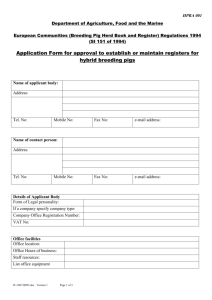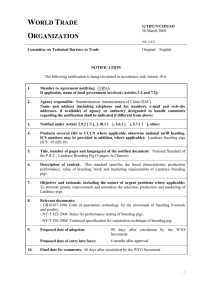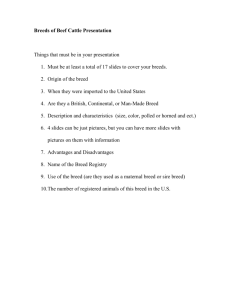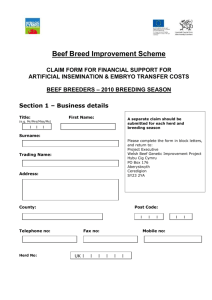UDC 636
advertisement
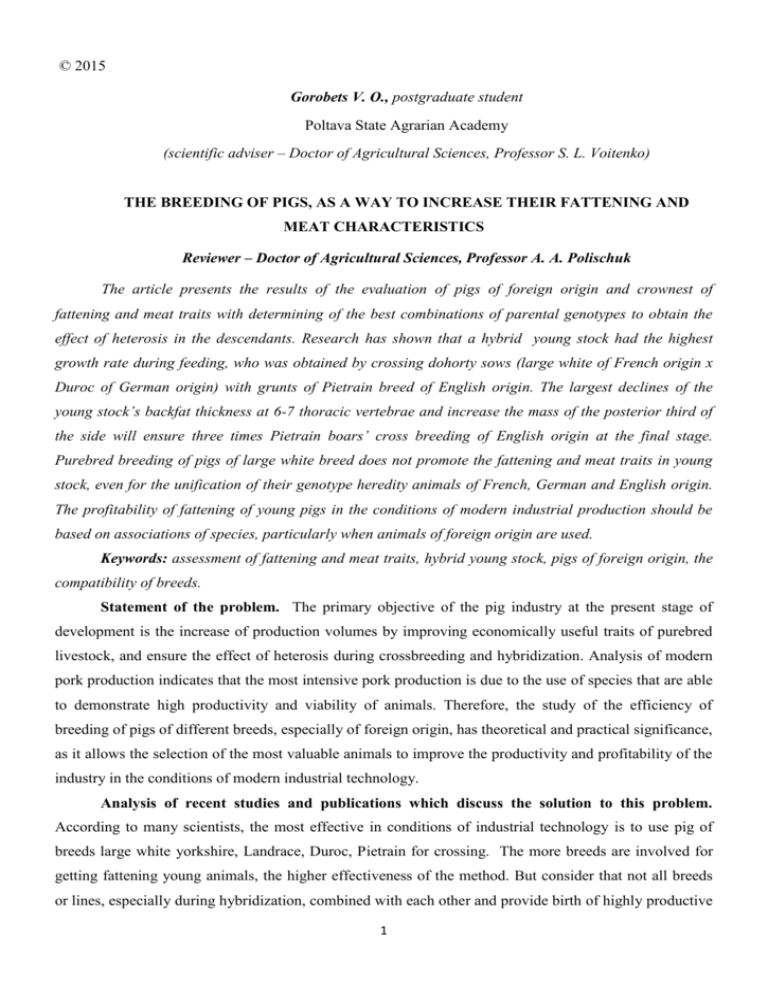
© 2015 Gorobets V. O., postgraduate student Poltava State Agrarian Academy (scientific adviser – Doctor of Agricultural Sciences, Professor S. L. Voitenko) THE BREEDING OF PIGS, AS A WAY TO INCREASE THEIR FATTENING AND MEAT CHARACTERISTICS Reviewer – Doctor of Agricultural Sciences, Professor A. A. Polischuk The article presents the results of the evaluation of pigs of foreign origin and crownest of fattening and meat traits with determining of the best combinations of parental genotypes to obtain the effect of heterosis in the descendants. Research has shown that a hybrid young stock had the highest growth rate during feeding, who was obtained by crossing dohorty sows (large white of French origin x Duroc of German origin) with grunts of Pietrain breed of English origin. The largest declines of the young stock’s backfat thickness at 6-7 thoracic vertebrae and increase the mass of the posterior third of the side will ensure three times Pietrain boars’ cross breeding of English origin at the final stage. Purebred breeding of pigs of large white breed does not promote the fattening and meat traits in young stock, even for the unification of their genotype heredity animals of French, German and English origin. The profitability of fattening of young pigs in the conditions of modern industrial production should be based on associations of species, particularly when animals of foreign origin are used. Keywords: assessment of fattening and meat traits, hybrid young stock, pigs of foreign origin, the compatibility of breeds. Statement of the problem. The primary objective of the pig industry at the present stage of development is the increase of production volumes by improving economically useful traits of purebred livestock, and ensure the effect of heterosis during crossbreeding and hybridization. Analysis of modern pork production indicates that the most intensive pork production is due to the use of species that are able to demonstrate high productivity and viability of animals. Therefore, the study of the efficiency of breeding of pigs of different breeds, especially of foreign origin, has theoretical and practical significance, as it allows the selection of the most valuable animals to improve the productivity and profitability of the industry in the conditions of modern industrial technology. Analysis of recent studies and publications which discuss the solution to this problem. According to many scientists, the most effective in conditions of industrial technology is to use pig of breeds large white yorkshire, Landrace, Duroc, Pietrain for crossing. The more breeds are involved for getting fattening young animals, the higher effectiveness of the method. But consider that not all breeds or lines, especially during hybridization, combined with each other and provide birth of highly productive 1 young stock. That is why the basis of research in pig breeding is the search for the most combined parental forms, including foreign origin. Analyzing breeding sows ½ (belarusian meat + Landrace) with boars of different breeds was established that the most high fattening traits characterized the young, which is heredity boars of Landrace and Duroc of canadian breeding [4]. A significant increase in fattening and meat traits in young animals contributes crossing dohorty females of large white x Landrace and large white x Landrace with grunts of Pietrain, Duroc and line Kantor [3]. However, to improve feeding signs can not only cross the crossing, but during the purebred breeding which provided that the parent genotypes belong to different animals of foreign origin. So, young breed Landrace, obtained by crossing females of french and german grunts breeding exceeded their other genotypes by age of achievement of a live weight of 100 kg in 2,9–23,2 days and had a high daily gains [2]. The carcasses of the young, where the father of the breed Pietrain was used to breed, had a high meat characteristics, when three breedcrossing and use of the breeding species of Pietrain and Duroc at the final stage, meat characteristics were higher than when two breeds cross [1]. Consider that industrial plants of various capacities for production of pork extensive use of foreign breeding pigs, as well as their descendants, are in the second and higher generations from imported livestock, we made an attempt to study the fattening and meat characteristics of hybrid youngsters from different backgrounds who have joined heredity pigs of French, German and English origin. The purpose and objectives of the research. The aim of our study was to find the most highperformance combinations of pigs of French, German and English origin, which would ensure for their descendants high fattening and meat characteristics. Objectives of the research were to study the fattening and meat traits over pigs of different origin, provided their feeding on deep unchanged litter and free access to feed. Methodology and research methods. Fattening and meat characteristics were studied over pigs of different origin, obtained by crossing two purebred sows with boars breeds of large white, Duroc, Pietrain of english origin. Experimental studies conducted in the conditions of the OOO «Agricorholding» in Chernihiv region by method of groups. Pigs of large white breed (WB), Landrace (L), Duroc (D) and Pietrain (P), which belonged to the French breeds (FO), German (GO) and English (EO) origin were used. Feeding signs were studied by age of achievement of a live weight of 100 kg and average daily gain and meat – the length of the carcass, the thickness of fat at the level of 6-7 thoracic vertebrae and the weight of the rear third of the carcasses according to standard techniques of pigs breeding. The results of the research. Our studies revealed that the combination of sows genotype ½ (large white + Duroc) with breed of Pietrain of English origin provided the descendants of the greatest growth rate and achievement of a live weight of 100 kg in the shortest time -179,6 days, which is in 17,9 days faster than pigs of large white breed of the control group and 5,6 -20,6 days – than hybrid young stock of different origin. 2 In their turn, the pigs of large white breed of the control group, which combines the genetics of animals of French, German and English breeding, live weight of 100 kg fattening reached for 197,5 days, which is faster at 2,7 days, only in comparison with young genotype 1/4 (large white + Landrace) + 2/4 Duroc), but longer in 2,7–17,9 days than all other animals of the studied genotypes. Probably pigs breeding of large white breed in different countries, which is mainly because of the rate of growth reached «selection plateau» and cannot provide young manifestation of the effect of heterosis during purebred breeding, which is the results of our research. Most unmatched, with both genetic and breeding point of view, should be considered interbreed selection of sows ½ (large white + Landrace) with boars of Duroc breed of English origin, which resulted in the reduction of age of achievement of a live weight of 100 kg, not only in comparison with purebred animals of large white breed, and hybrid animals of different origin. In General, analyzing the effectiveness of purebred breeding pigs of large white breed, which combines the genotypes of French, German and English descent and breeding crossbred sows obtained by combining the parent fundamentals of large white breed and Landrace of French origin and boars breeds Landrace and Duroc of German origin, with boars of large white breed, Duroc, Pietrain, you should make a conclusion about the advantage of pigs breeding of different breeds and origin age of achievement of a live weight of 100 kg fattening, except option ♀1/2 (large white + Landrace) + ♂Duroc. In our research the average daily weight gain of pigs for fattening had a negative correlation with age, achievement of a live weight of 100 kg, that is the animals had a higher daily gains, the more they are intensively formed in body weight, which was manifested at the age of reaching young live weight of 100 kg. Among experimental pigs the highest average daily gains – 677,9g and 659,8 g during fattening had animals, where the paternal breed was Pietrain at the final stage. Evaluation of experimental pigs for meat traits, namely the length of the carcass after 24 hours of cooling, the thickness of fat at the level of 6-7 thoracic vertebrae and the weight of the rear third of the carcasses gave the opportunity to assert the existence of certain differences between the genotypes, which were caused by the constitutional animal type and breed characteristics. So, the longest of the carcass after slaughter is 98,8 cm, was characterized by pig’s genotype ¼ (large white + landrace) + 2/4 large white, which is 0,6 cm exceeded animals of the control group and 1,9-4,4 cm hybrid young of different origin. In general, you should pay attention to the advantage of this characteristic of pigs, who inherited the traits of large white breed of different origin, as well as large white breed and Landrace. The young pigs, where at the final stage of getting breed Pietrain was used had the carcass of the shortest length – 94,4 cm, which was significantly lower than pigs of the control group. Pigs, where the paternal form at the final stage manufacturers Duroc was used breed had intermediate values. The thickness of back fat measured at the level of 6-7 thoracicvertebrae, indicates the lowest fat deposition of pigs, who probably inherited this trait in the breed Pietrain with the greatest thickness at purebred of young large white breed. The most notable decrease in the thickness of fat in the investigated point on the back of the pig provides various choices of the cross-matching of large white breed of French selection, Landrace and Duroc of 3 German selection, Pietrain of English breeding. It should also be pointed out that in our research the breed of Pietrain of English origin were reduced in the descendants of the thickness of fat on the lowest among the studied genotypes length of the carcass after slaughter. Simultaneously, the boars of large white breed, providing the descendants of the greatest length of the carcass during purebred breeding, did not provide the effect of heterosis on the thickness of back fat even during crossing with animals of meat cattle productivity. Weight of the rear third of the carcasses tended to prevail of pigs, who inherited the trait of the breed Pietrain. Conclusions: The obtained results allow to draw the following conclusions: 1. The most cost-effective in the conditions of modern industrial technology is the fattening of young stock, which is obtained by breeding sows ½ (large white + Duroc) with breed of Pietrain of English origin. 2. Boars and sows of large white breed of various foreign origin though and provide ink considerable length in the descendants, but also lead to higher fat deposition at the level of 6-7 thoracic vertebrae and the lowest weight in the rear third of the carcasses. 3. To get pigs, which have carcasses with low thickness of fat at the level of 6-7 thoracic vertebrae and surround the rear third of the carcasses is most expedient to feed the young animals obtained by crossing females (large white x Duroc) and (large white x Landrace) with breed of Pietrain of English origin. BIBLIOGRAPHY 1. Аниховская И. В. Влияние хряков импортных пород на откормочные и мясосальные качества помесного молодняка / И. В. Аниховская // Современные проблемы интенсификации производства свинины : междунар. науч.-практ. конф., 11-13 июля 2007 г.: тезисы докл. – Ульяновск, 2007. – Т.1. – С. 91–97. 2. Войтенко С. Л. Генотип свиней і його вплив на відгодівельні ознаки / С. Л. Войтенко, Б. С. Шаферівський // Вісник Сумського національного аграрного університету . – 2013 . – №1(22) . – С. 26–27. 3. Сусол Р. Л. Продуктивні якості свиней сучасних генотипів зарубіжної селекції за різних методів розведення в умовах Одеської області / Р. Л. Сусол // Вісник Сумського національного аграрного університету . – 2014. – Вип.2/2 (25). – С. 92–98. 4. Федоренкова Л. А. Генотип свиней и егов лияние на откормочные и мясные качества / [Л. А. Федоренкова, Р. И. Шейко, Н. М. Храмченко и др.] // Збірник наукових праць Вінницького національного аграрного університету. – Серія: Сучасні проблеми селекції, розведення та гігієни тварин. – 2012. – №4 (62). – С. 132–135. 4

